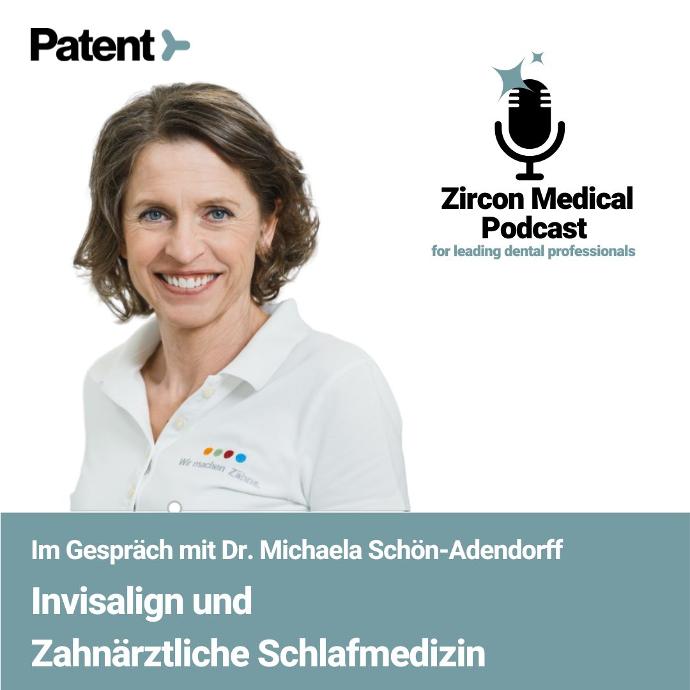Dr. Michaela Schön-Adendorff
Self-Employed Dentist
Dentist at the dental practice Dres.Schumacher + Schön-Adendorff in Essen-Kettwig
Dental practice chosen as “Practice of the Month” in July 2022 by Dr. Flexbooking
Specializes in implantology, periodontology, aesthetic dentistry, dental sleep medicine, and invisible tooth straightening
- Website: https://www.zahnarzt-kettwig.de
- Instagram: https://www.instagram.com/zahnarzt.kettwig/
- LinkedIn: https://www.linkedin.com/in/michaela-schön-adendorff-b718a320b/
Güterstraße 22, 45219 Essen-Kettwig, Germany
In Conversation with Dr. Michaela Schön-Adendorff
The enduring appeal of Invisalign treatment is obvious. You can straighten your teeth without relying on ugly metallic braces that cause self-consciousness and anxiety — what’s not to love? But as the world moves towards increased automation, there has also been a rise in online orthodontics delivered to a patient’s home without a consultation with a dentist. But such practices aren’t safe, and orthodontists are concerned about how such “treatments” are marketed online.
Our team at Zircon Medical recently hosted Dr. Michaela Schön-Adendorff, the (leading) dentist at Dres.Schumacher + Schön-Adendorff in Essen-Kettwig, on our podcast series to Invisalign treatment, the growing concern of online orthodontics, and the connection between sleep and the mouth.
Introducing Dr. Schön-Adendorff, one of the three (managing) dentists at Dres.Schumacher + Schön-Adendorff in Essen-Kettwig
Dr. Schön-Adendorff has been a self-employed dentist for over 25 years and is currently dentist at Dres.Schumacher + Schön-Adendorff, a dental clinic in Essen-Kettwig. She identifies as a mother, wife, and dentist specializing in implantology, periodontology, aesthetic dentistry, dental sleep medicine, and invisible tooth straightening.
When asked when she realized she wanted to be a dentist, Dr. Schön-Adendorff frankly admitted that dentistry was never a burning desire or passion. As a teenager, she became a trainee at a dental practice at her parents' insistence because she had no other firm ideas or aspirations. During the training, she learned a lot about teeth and the manual skills required to become a dentist.
After her training, she pursued her dental education. She tells of an event during her training in which her boss at the time took on the role of an assistant and had her place an amalgam filling on a model. Dr. Schön-Adendorff says she liked sitting on the other side of the dental chair, and that motivated her to complete her dental studies and training and become a dentist. After five and a half years of training, she returned to the practice that started it all — this time as a dentist.
Dr. Schön-Adendorff has been the co-owner of the dental practice for 22 years now, and the founder’s son has also joined the team. Dr. Schön-Adendorff’s son is also studying dentistry and is currently in his third semester.
Being selected as the Practice of the Month, 2022
Dres.Schumacher + Schön-Adendorff has recently been selected as the Practice of the Month by Dr. Flexbooking. When asked which factors contributed to their practice receiving this honor, she stated it’s their attention to service. Dr. Schön-Adendorff fosters a service-oriented environment at the dental practice, ensuring each patient feels safe and comforted through every stage of the dental care journey.
Their dedication to optimal service started way back in the 80s when they installed answering machines to allow patients to leave messages any time of the day or night. In addition to installing answering machines, the dental practice sent out recall postcards to patients to remind them of preventative care every six months. However, over time, thanks to digital advancements, they’ve made the dental clinic even more accessible.
Dr. Schön-Adendorff’s dental clinic has implemented an online appointment system that can be used 24 hours a day, seven days a week. Via the homepage, potential patients can book consultations or appointments with their preferred therapists from the comfort of their homes. Patients can even schedule appointments on Sunday afternoons when there’s no one available in the dental clinic.
The appointment booking system allows the dental clinic to indicate how long certain slots should be booked. For example, the system usually allocates 15 minutes for minor checkups, 30 minutes for a consultation, and 60 minutes for a professional dental cleaning. If the patient needs a procedure that exceeds these time slots, they must clarify the slot via telephone. The Dr. Flex system only activates times that are actually free, so there are no overlaps or long wait periods.
Invisalign instead of veneers or partial crowns
Dr. Schön-Adendorff says Invisalign treatment has truly broadened their horizons. Until recently, patients seeking to correct mild to moderate misalignment issues had to rely on dental veneers or partial crowns. But thanks to Invisalign, patients can correct gaps between the teeth, and other mild to moderate orthodontic concerns without adjusting the structure of their teeth. Furthermore, Dr. Schön-Adendorff may also recommend Invisalign to patients experiencing an orthodontic recurrence after having undergone teeth straightening as children.
However, Dr. Schön-Adendorff clearly emphasizes that patient cooperation is an essential component of the journey. Invisalign treatment requires a high degree of discipline on the patient’s part, especially since they must wear the aligners for at least 22 hours per day. The patient should only remove the aligners for oral hygiene or to eat. Generally speaking, Dr. Schön-Adendorff says most adult patients comply with the requirements because they opt for the procedure and pay out of pocket, which compels them to ensure the treatment’s success.
Ongoing monitoring is essential for Invisalign
Dr. Schön-Adendorff emphasizes the need to monitor patients regularly during the Invisalign journey. She gives her patients a maximum of four aligners, which they have to change at home at a certain time. Once the patient moves through all four aligners, they have another consultation with the dentist to ensure the treatment is progressing correctly. If necessary, Dr. Schön-Adendorff may have to take another set of impressions and create another set of aligners for the rest of the treatment.
The treatment must also be planned according to the targeted teeth. The canines and upper lateral incisors, for example, take longer to move or may need fine-tuning at the end of the wearing period. If the patient doesn’t have the desired results at the end of the Invisalign treatment, they may receive another set of aligners at no additional cost. Dr. Schön-Adendorff believes Invisalign providers must not leave their patients alone for too long.
The dangers of direct-to-consumer orthodontics
Dr. Schön-Adendorff says Invisalign treatment and orthodontics are extremely complex and involved procedures. The layman can’t possibly complete the treatment without close monitoring. Dr. Schön-Adendorff views the availability of direct-to-consumer orthodontics to be negligent and unsafe. Once the patient has paid for the complete set of aligners, he is left to his own devices, which can lead to disaster.
In fact, Dr. Schön-Adendorff says she has received numerous patients who need to undergo another round of orthodontic treatments because direct-to-consumer aligners severely damage their teeth. She believes app-based controls and monitoring can’t offer the same care that dentists can provide, and relying on apps to monitor progress can lead to numerous dental problems that need further treatments later. She says she prefers to observe her patients’ teeth with her own eyes.
The connection between dentistry and sleep
Dr. Schön-Adendorff says dental sleep medicine is an essential component of dentistry, but it requires additional knowledge about sleep disorders and sleep-related breathing disorders. Snoring often occurs (due to a lack of oxygen at night) because the throat muscles relax and block the airways. The lack of proper sleep can lead to drowsiness and an inability to be productive, which can be disastrous in some situations, such as for drivers.
Sleep apnoea and snoring occur, for example, when the throat and tongue muscles relax and the lower jaw slides back with your tongue, which leads to a complete or partial blockage of the airway. This condition can be worsened by low tissue tension, being overweight, or being a certain age. Sleep apnea is such a problem that the patients affected don’t realize that something is wrong. Often it is the person sleeping next to them in bed who wants snoring therapy.
Patients don’t usually visit dentists for snoring directly. They may visit an ENT (Ear, Nose, and Throat) doctor or family doctor, who may refer them to dentists if they notice signs of improper breathing. The ENT specialist may refer the patient to a dentist for oral appliances and splints that can keep the airway open and allow them to sleep comfortably. Oral appliances, so-called mandibular protrusion splints, can keep the airways open to reduce snoring and improve oxygen supply.
Dr. Schön-Adendorff can be found via LinkedIn or Instagram. You can also listen to her on the latest episode of the Zircon Medical Podcast.











